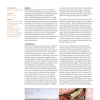Free Online Productivity Tools
i2Speak
i2Symbol
i2OCR
iTex2Img
iWeb2Print
iWeb2Shot
i2Type
iPdf2Split
iPdf2Merge
i2Bopomofo
i2Arabic
i2Style
i2Image
i2PDF
iLatex2Rtf
Sci2ools
IV
2007
IEEE
2007
IEEE
Aesthetic Primitives of Images for Visualization
Images play an important role in visualization. As users are more willing to adopt a product if it evokes pleasurable feelings the aesthetic appeal of interfaces becomes more important. Thus, there is a growing need to generate also images which appear aesthetically to the user. Starting with the modularities of the human visual system, we derive six dimensions of visual aesthetics. For each dimension we explore, inspired by principles of the visual arts and insights of cognitive neuroscience, which pecularities of the dimensions are particularly adequate for an aesthetic impression. Accompanied by a fair number of image examples, these considerations result in an easy to understand guideline for computer scientists and interface designers how to deal with images in terms of aesthetics.
| Added | 04 Jun 2010 |
| Updated | 04 Jun 2010 |
| Type | Conference |
| Year | 2007 |
| Where | IV |
| Authors | Gabriele Peters |
Comments (0)

